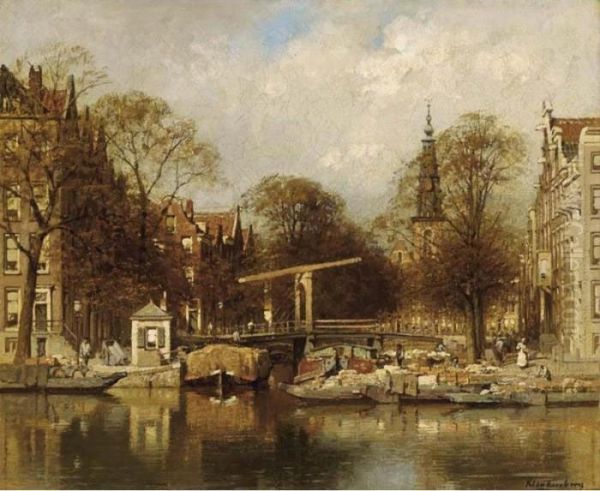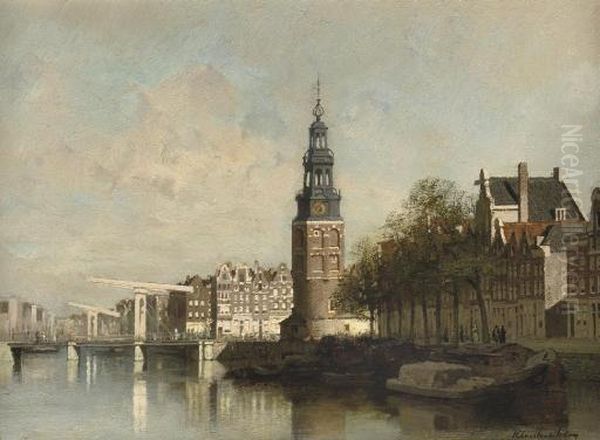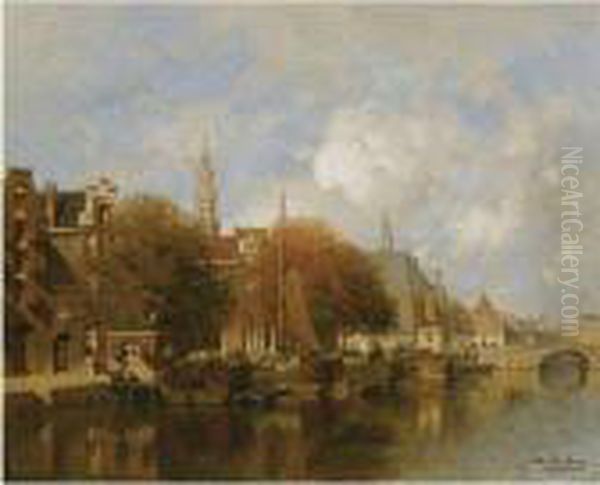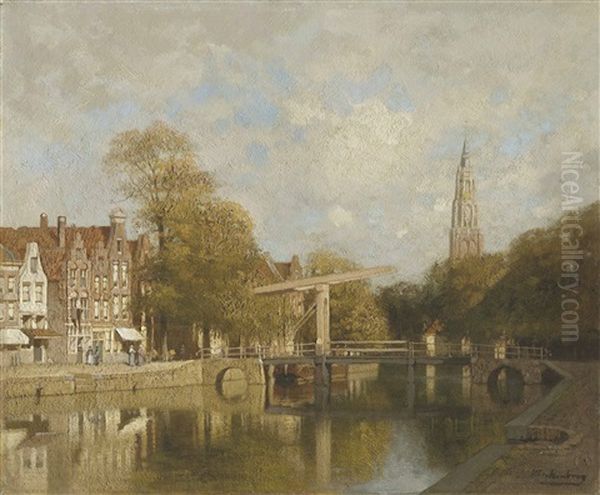Johannes Christiaan Karel Klinkenberg stands as a significant figure in late 19th and early 20th-century Dutch painting. Renowned primarily for his luminous and meticulously rendered cityscapes, particularly of Amsterdam and The Hague, Klinkenberg captured the unique atmosphere and architectural beauty of the Netherlands with a distinctive clarity and brightness. His work bridges the Dutch tradition of topographical painting with a more modern sensibility towards light and colour, securing his place as a beloved chronicler of urban life.
Early Life and Artistic Inclination
Born in the administrative heart of the Netherlands, The Hague, on January 14, 1852, Johannes Christiaan Karel Klinkenberg was the tenth child of Leendert Klinkenberg. From a young age, the boy displayed a clear propensity for drawing and painting, an interest that set him apart from the career paths envisioned by his parents. His father hoped he would pursue a more conventional and financially secure profession, such as mechanical engineering, while his mother harboured ambitions for him to become a doctor.
Despite these parental expectations, Klinkenberg's artistic calling proved undeniable. His passion for visual expression led him, at the relatively young age of thirteen, to enrol in the prestigious Hague Academy of Art (Haagsche Teeken-Academie). This early commitment to formal artistic training laid the foundation for his future career and demonstrated a determination to follow his own path, even against familial preferences.
During his time at the Academy, Klinkenberg began to form important connections with fellow aspiring artists. He developed close friendships with contemporaries such as Evert Jan Bok (also spelled Boks) and Louis Apol, the latter known for his evocative winter landscapes. These early relationships provided camaraderie and likely fostered a stimulating environment for artistic growth and experimentation. Sources suggest they sometimes painted together outdoors, perhaps engaging in early forms of en plein air study.
Formative Training and Influences

Klinkenberg's formal art education continued under the tutelage of established painters who significantly shaped his technical skills and artistic vision. Initially, he studied with Louis Meijer, a respected painter known for his dramatic seascapes and landscapes. Meijer's influence likely contributed to Klinkenberg's understanding of composition and the depiction of natural elements, particularly water and sky, which would become crucial components of his later cityscapes.
Subsequently, Klinkenberg became a pupil of Christoffel Bisschop. Bisschop was a versatile artist acclaimed for his genre scenes, historical subjects, and particularly his masterful handling of light and shadow within interior settings, often rendered with rich colour and texture. Bisschop's guidance was pivotal in developing Klinkenberg's own sensitivity to the effects of light. While Bisschop often focused on indoor light, Klinkenberg adapted these lessons to capture the bright, often sun-drenched, exteriors of Dutch cities.
Although influenced by Bisschop's technical prowess, Klinkenberg ultimately diverged from his teacher's preferred subject matter. Instead of pursuing historical scenes or intimate interiors, Klinkenberg found his true calling in the depiction of the urban environment. This shift, occurring relatively early in his career, marked the beginning of his specialization in cityscapes.
The Emergence of a Signature Style
From his twenties onwards, Johannes Christiaan Karel Klinkenberg dedicated himself increasingly to the genre of the cityscape, or veduta. He quickly established himself as a leading specialist in this field within the Netherlands. His style became characterized by a remarkable clarity, a bright and optimistic colour palette, and an exceptional ability to render the interplay of sunlight, architecture, and water.
Klinkenberg's paintings often depict sunny summer days, showcasing clear blue skies reflected in the calm waters of canals. He possessed a keen eye for architectural detail, meticulously rendering the facades of historic buildings, bridges, and bustling squares. His compositions are typically well-balanced and harmonious, offering picturesque views that are both accurate and aesthetically pleasing. He particularly excelled at capturing the reflections on water and the subtle nuances of light hitting different surfaces, giving his works a vibrant, almost photographic quality, yet imbued with an artist's sensitivity.
His preferred subjects were the iconic cities of the Netherlands. Amsterdam, with its intricate network of canals and historic gabled houses, featured prominently. He also frequently painted views of The Hague, his hometown, as well as Rotterdam and Alkmaar, among others. Each city was rendered with attention to its specific character and landmarks, yet unified by Klinkenberg's consistent stylistic approach.

Artistically, Klinkenberg's work occupies an interesting position. It draws on the long tradition of Dutch topographical painting dating back to the 17th century masters like Jan van der Heyden and Gerrit Berckheyde, who also specialized in detailed city views. However, Klinkenberg infused this tradition with a distinctly 19th-century sensibility, incorporating elements associated with Romanticism in its picturesque quality, and even touches of Impressionism in its focus on light and atmosphere, though without adopting the looser brushwork typical of French Impressionists. His bright palette often contrasted with the more tonal and atmospheric approach favoured by many of his Hague School contemporaries like Jacob Maris or Anton Mauve.
Key Themes and Favourite Subjects
Throughout his mature career, Klinkenberg remained devoted to capturing the essence of Dutch urban life. His paintings celebrate the unique charm and beauty of cities built around water. Canals are almost ubiquitous in his work, serving not just as compositional elements but as reflective surfaces that amplify the light and colour of the scene. He masterfully depicted the interplay between water, sky, and the built environment.
A particular fascination for Klinkenberg was the rich architectural heritage of the Netherlands. He frequently chose views that highlighted significant historical buildings, churches, and towers. His repeated depictions of the Montelbaanstoren, a 16th-century defensive tower in Amsterdam, underscore this interest. These structures were not merely recorded; they were presented as integral parts of the living city, often bathed in sunlight that emphasized their texture and form.
While architectural accuracy was important, Klinkenberg's paintings are more than just topographical records. They convey a sense of place and time, often capturing the gentle activity of daily life – boats navigating the canals, figures strolling along the quaysides, the general hum of the city under a benevolent sky. His consistent preference for bright, sunny conditions lends his oeuvre an overall feeling of optimism and vitality.
Notable Works and Representations
Klinkenberg's prolific output includes many celebrated paintings that exemplify his style and preferred subjects. Among his representative works are:
View of the Groenburgwal with the Zuiderkerk, Amsterdam: This painting is a classic Klinkenberg cityscape, showcasing his ability to combine architectural detail (the prominent church tower) with a picturesque canal view, likely rendered with his characteristic bright light and clear reflections. It represents a blend of Dutch tradition and his personal, luminous style.
A Blacksmith's Yard by a Canal, Amsterdam: Documented as measuring 58.4 x 77.5 cm, this work appeared at a Christie's auction in Amsterdam in 1992. It likely depicts a scene of urban industry set against the backdrop of a canal, offering a glimpse into the working life of the city, framed by Klinkenberg's typical attention to light and setting.

The Plaats, The Hague: Measuring 101.4 x 60.8 cm, this painting captures a well-known square in Klinkenberg's native city. Such works demonstrate his ability to handle the perspective and complexity of open urban spaces, populating them with figures and architectural elements under his signature sunny conditions.
The Oude Rijn with the Marekerk, Leiden: This work, with recorded dimensions of 39.3 x 51 cm, depicts a scene in Leiden featuring the Old Rhine river and a notable church. While one source associates the date 1852 with this work, this is likely an error or refers to the scene depicted rather than the date of execution, as Klinkenberg was born that year. It nonetheless represents his interest in capturing the charm of various Dutch cities.
The Montelbaanstoren, Amsterdam: As mentioned, this historic tower was a recurring and important theme for Klinkenberg. He painted it multiple times from different viewpoints and under varying light conditions, demonstrating his sustained engagement with specific architectural landmarks and their picturesque qualities within the Amsterdam cityscape.
Sunset View along an Amsterdam Canal: This title, mentioned in the source material, suggests Klinkenberg also explored different times of day, capturing the warmer hues and potentially more dramatic light effects of sunset, adding another dimension to his urban repertoire.
These examples highlight Klinkenberg's focus on specific, identifiable locations, rendered with his characteristic precision, bright illumination, and compositional harmony.
Professional Life, Recognition, and Connections
Klinkenberg achieved considerable success and recognition during his lifetime. His move to Amsterdam in 1887 marked a period of intense focus on depicting the Dutch capital, resulting in many of his most famous works. His paintings, with their appealing subject matter and technical brilliance, found favour with collectors both in the Netherlands and abroad. This success allowed him and his family to live comfortably.
In 1893, Klinkenberg married Cornelia Gerianne Marie van der Meulen. The couple had three children and enjoyed a prosperous family life, supported by the artist's flourishing career. His work was sought after, and he attracted patrons from outside the Netherlands, indicating his growing international reputation.

He was an active member of the artistic community, notably belonging to the prestigious Pulchri Studio artists' society in The Hague. This association provided opportunities for exhibition and interaction with fellow artists. Klinkenberg received several awards for his work throughout his career, further cementing his status. His paintings were regularly featured in exhibitions, including a significant honorary exhibition (Eere-tentoonstelling) held at Pulchri Studio in 1924, the year of his death.
His works continue to be held in public collections, including the Teylers Museum in Haarlem, one of the oldest museums in the Netherlands, which holds collections spanning art and science. Furthermore, Klinkenberg's paintings remain popular on the art market, frequently appearing at major auction houses like Christie's, attesting to their enduring appeal.
Contemporaries and the Dutch Art Scene
Johannes Christiaan Karel Klinkenberg worked during a vibrant period in Dutch art history. His career overlapped with the Hague School, a movement known for its realistic and often atmospheric depictions of Dutch landscapes, peasant life, and coastal scenes. Key figures of the Hague School included Jacob Maris, Willem Maris, and Matthijs Maris, Anton Mauve, Jozef Israëls, Hendrik Willem Mesdag, Willem Roelofs, and Paul Gabriël. While Klinkenberg shared their Dutch context and commitment to realism, his focus on bright, sunny cityscapes differentiated him from the often more muted, tonal palettes and rural or coastal subjects of many Hague School painters.
His early friendships with Evert Jan Bok and Louis Apol place him within the network of artists training in The Hague. His association with the Pulchri Studio connected him with a wide circle of artists, potentially including figures like Hermanus Koekkoek (part of a famous family of marine painters) and Cornelis van der Veen, mentioned in the source material as fellow members. He would also have been aware of the emerging Amsterdam Impressionism, represented by artists like George Hendrik Breitner and Isaac Israëls, who depicted urban life in Amsterdam with a looser, more dynamic brushwork and often focused on the bustling energy and social aspects of the modern city, providing a stylistic contrast to Klinkenberg's more serene and detailed views. Johannes Bosboom, known for his atmospheric church interiors, was another contemporary focused on architectural subjects, albeit primarily interiors. Klinkenberg navigated this rich artistic landscape, developing and maintaining his unique niche.
Legacy and Conclusion
Johannes Christiaan Karel Klinkenberg passed away in 1924, at the age of 72, leaving behind a substantial body of work that continues to be admired for its technical skill and evocative portrayal of Dutch cities. His primary contribution lies in his specialization in the sunlit cityscape, a genre he mastered with exceptional finesse. He successfully merged the detailed observational tradition of 17th-century Dutch painting with a brighter, more modern palette sensitive to the effects of light, influenced perhaps by broader European trends but ultimately distinctly his own.
He stands apart from the dominant Hague School through his choice of subject and his preference for clear, bright conditions over moody atmospheres. His paintings offer an idealized yet recognizable vision of Amsterdam, The Hague, and other Dutch urban centers at the turn of the 20th century. They capture a sense of timeless charm, architectural beauty, and the tranquil vitality of life along the canals.
Today, Klinkenberg is remembered as a master of light and reflection, an artist who celebrated the unique character of the Netherlands' cities with precision, clarity, and an enduringly appealing aesthetic. His work remains popular with collectors and the public, offering luminous windows onto the Dutch urban landscape of a bygone era.